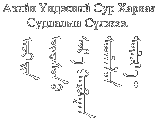

The Bow - Weapon of the Ancient Buryat People
by Kh. D. Gombojapova, Buryat State University
In the minds of modern peoples, the bow and arrow carries connotations of being 'simple' or 'na´ve' - something intended just for sport or entertainment. But in truth, the bow and arrow have played an important role in the development of mankind and occupy an outstanding place among the inventions of primitive man.
Archaeology shows us that bows and arrows have been around since Neolithic times. In his work "The Origin of the Family, Private Property and the State", Engels comprehensively covered the subject of the bow, the conditions under which it was invented and the value of its invention. He wrote:
"The bow was already a very complex weapon representing a long period of accumulated experience, refinement of mental power and the coordinated understanding of the relationship between a range of other inventions. Even at its simplest, the bow is rather complex in its overall constitution, combining as it does the bow itself, the string and the arrow shaft which must interact mechanically in a complex fashion."
With the invention of the bow, mankind learned to master the resistance of materials combined with latent mechanical power. The appearance of the bow represented a great step in practical cognition of the laws of nature by primitive people and a sharp shift in the technology of those times. The invention of the bow and arrow and their use as weapons rapidly raised the efficiency of the hunt and from that time on ensured greater consistency than previously in maintaining the supply of food at a lesser expense of energy.
Pointing to the role of the bow and arrows, F. Engels wrote: "The bow and arrow became the decisive weapon in an epoch of savagery. Their appearance heralded a high level of development, and through them, hunting for game became one of the normal branches of labour."
For many countries and cultures, the bow and arrow have served as the main projectile weapon for a very long time. The primeval bow underwent gradual change, and improving with the experience of the user gained greater latent power and lightness in the hand, thus enhancing its value as a weapon.

Click for a map of the Buryat Region (shown in red)
The ancient Buryat people lived in very close interdependence with the natural world around them. Life was uncomfortable and dangerous - something which served to ensure that in order to assure a supply of food, it was necessary to hunt cooperatively. This gave rise to what has come to be known as the 'communal hunt', the leaders of which were the most able marksmen. Such hunts were popular among the Buryats. A well-known ethnographer, M. N. Khangalov, wrote about Nomoshke Gabachaev from Balagan District who was both a great leader and expert marksman. He was distinguished by the accuracy of his shooting in local drag-net hunts. These were professional drag-net hunters and relied on it for their livelihood.
Drag-net hunting was common in early times among the Buryat people when they lived a nomadic existence and could not obtain sufficient food supplies. But over time, they took up livestock farming and drag-net hunting ceased to have real value. By the time the Russians came to Buryatia the drag-net hunt had already ceased to be a strong social function. Those drag-net hunts taking place at the end of the XIX Century had already lost their economic impetus and had difficulty in attracting local interest.
The drag-net hunting described by Khangalov as well as by the authors and chroniclers of the Khorinsk and Barguzin Buryats was organised for hunting wolves which were attacking their domestic animals, as well as for a kind of amusement in their free time. At the time of the old drag-net hunts, archery competitions were common among the Buryats, bringing to the hunt the skills of warfare. People were prepared to make great efforts to become deft marksmen, mounted on horseback. This is repeatedly mentioned in Buryat historical chronicles.
In his Chronicles, F. Joboev wrote "...the Khorinsk Buryats were constantly engaged in archery. From the age of thirteen or fourteen years, males were required to make bows and arrows and to learn to shoot on horseback."
With the passing of time, archery is now no more than a competitive sport and popular pastime among the public.
Up-dated 1 March 1999